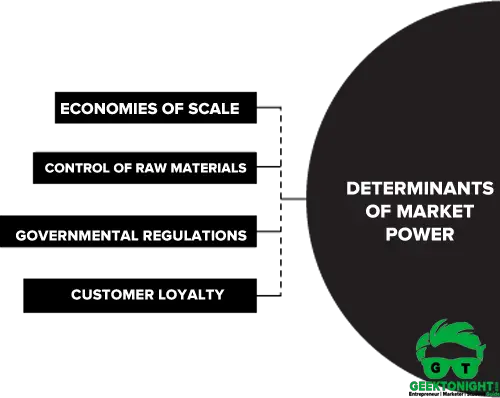What is Market Power?
Market power define as the ability of an organisation to raise the market price of a good or service over marginal cost to achieve profits. It can also be defined as the degree of control an organisation has over the price and output of a product in the market.
A firm with total market power is in a position to raise the prices without any loss of customers. This type of control generally occurs in imperfect competition.
Organisations having total market power are also known as price makers. On the contrary, organisations have no market power in perfectly competitive markets. Such organisations are known as price takers.

Table of Content
Market Power Definition
Market power can be defined as an organisation’s ability to increase the market price of a good or service over marginal cost to achieve profits. It is also considered as a measure of the degree of control an organisation has over the price and output of a product in the market.
Also Read: Elasticity of Demand
Measurement of Market Power
In the market, the share of an organisation can be determined by measuring its market power. The most common measure for determining market power is concentration ratios. These ratios are used to determine the degree of control of firms in the market.
Concentration Ratios
Concentration ratios can be defined as a measure of market power in relation to the size of the business firm with that of the product’s size.
There are two types of concentration ratios: four-firm concentration ratio and eight firm concentration ratio.
- Four firm concentration ratio: It can be defined as the fraction of output produced by the top four organisations in an industry.
- Eight firm concentration ratio: It can be defined as the fraction of output produced by the top eight organisations in an industry.
Both these ratios are used to provide a clear view of industry concentration in the market.
For example, in the case of cigarettes, the four biggest organisations have 98 percent share in the US market. These concentration ratios may range from 0 to 100 percent, where a 0 percent concentration ratio is an indication of a highly competitive market and a 100 percent concentration ratio indicates a highly oligopolistic market that is imperfectly competitive.
Types of Concentration
The concentration ratios fall under three types of concentration, discussed as follows:
- Low concentration: An industry is considered to be under low concentration ratio if its concentration ratio falls bewteen 0 and 50 percent. Monopolistic competition falls into the bottom of this with oligopoly emerging near the upper end.
- Medium concentration: An industry is considered to be under medium concentration if its concentration ratio is from 50 to 80 percent. Example of such industries are very much oligopoly.
- High concentration: An industry is considered to be highly concentrated if its concentration ratio falls between 80 and 100 percent. Government regulators generally fall under this category.
In addition to Concentration ratios, there is another method that is used to determine the market power, i.e., Herfindahl-Hirschman Index (HHI).
Herfindahl-Hirschman Index: This index is used as an indicator of competition among organisations in an industry. Thus, it helps in determining if the industry is competitive or moving towards monopoly.
The HHI is calculated by squaring the market share for each firm (up to 50 firms) and then summing the squares. HHI comes close to zero in a perfectly competitive market, whereas in a monopoly, HHI nears 10,000. Let us understand the estimation of market share using HHI.
Also Read: Types of Market Structures
Determinants of Market Power
The market power of organisations is threatened, when there is a new entrant in the market. Thus, as long as there are barriers to entry, the market power of the existing organisations remains strong. These barriers often act as the determinants of market power of organisations.
For example, retail stores have generally very low market power as it is easy for a new participant to enter the market. There are various determinants of market power that explain the existence of organisations’ control in the market. Some of the important determinants of market power are shown in Figure.
There are 4 major determinants of market power:

Let us discuss these determinants of market power in detail, as follows:
Economies of scale
It often occurs that the organisation that has a fair amount of the share in the market produces large quantities to maximise its profit. Thus, when a new organisation decides to enter the market, it has to produce in large quantities to keep its cost low in comparison to the market rulers. Thus, economies of scale actually indicate the market power of an organisation in the market.
Governmental regulations
Governmental regulations also act as a major determinant of market power. In the market, where these regulations are strict and numerous, there is a strong control of the existing organisations.
For instance, by licensing and franchising monopolies are created along with government decree. In such a scenario, starting up a new venture becomes difficult due to the high market power of the leaders.
Control of raw materials
An important determinant of market power is the control of raw material supplies in the market.
For instance, an organisation that controls the supply of all the raw materials required for a product in the market may refuse to sell the raw materials at low prices to make the manufacturing organisations compete.
Customer loyalty
With time, an organisation builds its reputation in the market. In the eyes of customers too, these organisations hold a great image. Thus, customers find it difficult to switch to other products, even at a low price. Due to brand establishment in the market, the market power of the organisation remains high making it difficult for new entrants to gain share in the market.
Also Read: Law of Diminishing Marginal Utility
Business Economics Tutorial
(Click on Topic to Read)
Go On, Share article with Friends
Did we miss something in Business Economics Tutorial? Come on! Tell us what you think about our article on Market Power | Business Economics in the comments section.
Business Economics Tutorial
(Click on Topic to Read)













